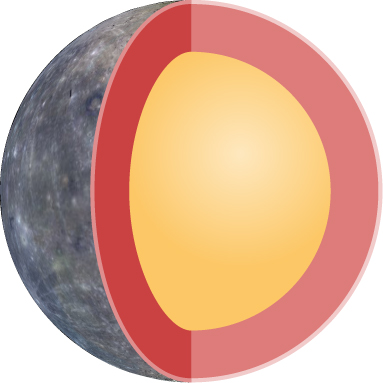| << Chapter < Page | Chapter >> Page > |
By the end of this section, you will be able to:
The planet Mercury is similar to the Moon in many ways. Like the Moon, it has no atmosphere, and its surface is heavily cratered. As described later in this chapter, it also shares with the Moon the likelihood of a violent birth.
Mercury is the nearest planet to the Sun, and, in accordance with Kepler’s third law, it has the shortest period of revolution about the Sun (88 of our days) and the highest average orbital speed (48 kilometers per second). It is appropriately named for the fleet-footed messenger god of the Romans. Because Mercury remains close to the Sun, it can be difficult to pick out in the sky. As you might expect, it’s best seen when its eccentric orbit takes it as far from the Sun as possible.
The semimajor axis of Mercury’s orbit —that is, the planet’s average distance from the Sun—is 58 million kilometers, or 0.39 AU. However, because its orbit has the high eccentricity of 0.206, Mercury’s actual distance from the Sun varies from 46 million kilometers at perihelion to 70 million kilometers at aphelion (the ideas and terms that describe orbits were introduced in Orbits and Gravity ).
Mercury’s mass is one-eighth that of Earth, making it the smallest terrestrial planet. Mercury is the smallest planet (except for the dwarf planets), having a diameter of 4878 kilometers, less than half that of Earth. Mercury’s density is 5.4 g/cm 3 , much greater than the density of the Moon, indicating that the composition of those two objects differs substantially.
Mercury’s composition is one of the most interesting things about it and makes it unique among the planets. Mercury’s high density tells us that it must be composed largely of heavier materials such as metals. The most likely models for Mercury’s interior suggest a metallic iron-nickel core amounting to 60% of the total mass, with the rest of the planet made up primarily of silicates. The core has a diameter of 3500 kilometers and extends out to within 700 kilometers of the surface. We could think of Mercury as a metal ball the size of the Moon surrounded by a rocky crust 700 kilometers thick ( [link] ). Unlike the Moon, Mercury does have a weak magnetic field. The existence of this field is consistent with the presence of a large metal core, and it suggests that at least part of the core must be liquid in order to generate the observed magnetic field. Recall from the Radiation and Spectra chapter that magnetism is an effect of moving electric charges. In atoms of metals, the outer electrons are easier to dislodge and they can form a current when the metal is in liquid form and can flow.


Notification Switch
Would you like to follow the 'Astronomy' conversation and receive update notifications?